| |
|
|
| |
|
 |
| |
 |
Every
year vast areas of the Amazon are burned or destroyed as farmers
and ranchers ignite their lands, converting forest into open fields,
claiming that this methodology is the only possible way to have
productive agriculture systems in the region. Slash and burn agriculture
is still responsible for the destruction of most of the primary
forest of Amazonia. Fire erodes the capacity of this unique ecosystem
to support life, by releasing available nutrients into the atmosphere,
by exposing soil to the erosive forces of wind and rain and by
destroying the populations of animals and plant species. Fire
is the single greatest threat to the biological integrity of the
largest and richest tropical forest system on the planet. Fire
is know to be the necessary sin on the agriculture frontier of
the Amazon, enhancing the short term productivity of farmers,
but reducing the long term economic viability of proper land use
and sustainable productive systems. A new model for land use development
is needed for the Amazon, restricting the unnecessary destruction
of primary forest by increasing the profitability of permanent
agricultural and sustainable forestry system in landscape already
occupied. These productive systems based on sustainable productive
cycles must be intensified, as the future of the Amazon is still
undefined.
A SOLUTION
One practical solution to this ongoing situation is to insert
the practice of permanent agriculture - permaculture - as a preferred
cultural land use system. Permaculture is an interdisciplinary
and integrated design system for creating sustainable and productive
human environments, in balance with nature. Its capacity includes
meeting human requirements in small intensively cultivated areas
thereby relieving the pressure on the rainforest and promoting
intrinsic values such as protecting biodiversity. In order to
protect biodiversity we must first create productive and self
reliant systems. We must apply this understanding in the design
and implementation of sustainable communities and the manner in
which houses are constructed, food is cultivated, how we recycle
natural energy and how finance is conducted. This we call Permaculture
design. The term Permaculture is formed by a simple coalition
between two words: permanent and agriculture. Permaculture was
created and developed by Bill Mollison, a devoted Australian scientist,
that has spent a lifetime spreading the techniques of Permaculture
around the world. He established a fund to enable Permaculture
teachers to reach groups in needs, particularly in the poorest
parts of the world. Now, certified professionals all over the
world teach full design Permaculture courses, using ecological
design as a tool to re-create productive natural ecosystems that
have fertility, diversity, stability and resistance.
With Permaculture it is possible to create a productive human
settlement without destroying the surrounding ecosystems. By uniting
age-old knowledge with modern scientific discoveries, is possible
to develop rural properties that are productive, viable and secure
for the farmer. The basic principles of Permaculture can be applied
with excellence in the tropics or in any other biome in Brazil,
creating adequate social and environmental solutions for the country.
In Brazil, the rural family is in desperate need of information
and resources that will allow them to survival in harmony with
the environment. We need to provide practical solutions for these
rural communities. With Permaculture it is possible to create
models that considers rural economic aspects, appropriate technology,
soil recovery, water management, alternative energy and bio-architecture.
Permaculture is a true holistic system of planning for humankind's
permanence on Earth. In Permaculture we look at problems as the
root for their solutions. |
| |
|
 |
|
|
|
In
1997, a Permaculture Reference Center for the Amazon was established
at the Federal Agricultural School of Manaus on nine hectares
of abandoned, degraded land. The Project was initially supported
by the Daniel Dazcal Foundation, the Permaculture Institute of
the Amazon (IPA), Permacultura America Latina (PAL) and the Federal
Agriculture School of Manaus. The mission of the project was to
create a Permaculture Demonstration Site that is specifically
adapted to the Amazonian environment. It was established on the
outskirts of the city on destroyed pasture that had long been
abandoned. By promoting new sustainable practices that are applicable
to the family farm and community, we are showing that it is possible
to create integrated production systems that supply the needs
of human populations without degrading the environment. These
integrated systems are designed to create a symbiotic relationship
between a set of plants, animals, structures and people in which
the products of one element supply the needs of another. This
reference project is a permanent nucleus for the diffusion of
knowledge, techniques and methods of Permaculture specifically
oriented to the Amazon region. The project also demonstrates that
only three hectares is really necessary to meet most of a family's
food requirements even on the poorest of soils.
Project Objectives
- To promote and disseminate Permaculture techniques within the
Amazonian region through the establishment of a Permaculture Reference
Unit within the Federal Agricultural University of Amazonas.
- To establish and develop a sustainable agriculture model for
Amazonian communities and families, based on diversity and alternative
productive system.
- To establish a living seed bank containing a diverse range of
tropical fruits and medicinal plants that will be accessible to
the public.
- To teach and train new Permaculture leaders through out the
region.
|
|
| |
|
|
|
|
|
| |
|
|
 |
|
Nursery
(Zone1)
|
|
 |
ACTIVITIES
All activities of the project follow the basic principles of Permaculture
design. The area is divided into zones of activity according to
the internal energy requirements of the system. In short, the
project is zoned based on the relative location of the elements,
their functions and a plan for the efficient utilization of energy
in relation to the utilization and management of natural resources.
An ideal criteria for defining the zones is the frequency of visits
necessary to maintain a particular element or sector. Zones one,
two and three are areas of high-energy input or frequent visits
where many activities are concentrated. Several visits may be
needed each day for the upkeep of these areas. It is important
to emphasize what function each zone serves in supporting the
functions and elements of the other zones. In this way a truly
integrated system is formed. During the initial period of the
project, development was concentrated in these three different
zones. |
|
| |
|
|
|
|
|
 |
|
Central
Nursery
|
| |
|
|
 |
|
Compost
Production (Zone 1)
|
|
 |
ZONE
ONE
Zone one consists of a plant nursery and an area immediately
surrounding it (this would represent a family house in a rural
system). It is the project nucleus and origin of all our field
activities. From the cataloging, selection and preparation of
seeds to the production of diverse species of seedlings for planting
in other zones, the nursery is considered the cradle where the
cycle of life begins. In this zone, it is possible to create many
productive growing spaces, even using the areas along the walls
(and other vertical apaces) for food production on trellises.
In close proximity to the nursery, we have implanted various diverse
systems of vegetable production with the objective of reproducing
models of semi-intensive home gardens. Zone one also contains
seedbeds, hillside terrace crops, rabbit/worm integrated compost
production systems, banana circles, and a classroom.

|
Seedbeds
- Organic Production (Zone 1)
|
|
|
| |
|
|
|
|
|
 |
|
Chicken
Tractors (Zone 2)
|
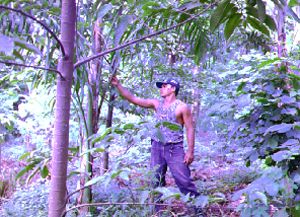 |
|
Alley
Production System
|
|
 |
ZONE
TWO
Adjacent to zone one, it is utilized for the planting of perennials,
mixed systems and intensively managed agroforestry. It also includes
animal systems that require frequent attention. In this sector
we have established an alley cropping system for the diverse production
of fruits. Integrated into the alley cropping system is a poultry
system for the production of wild-birds, chickens, ducks, geese
and all of their derivatives. Manure, an important resource for
the production of organics, is fully utilized in planting and
compost making as a nitrogen rich fertilizer.
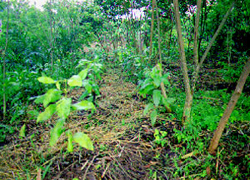
|
|
| |
|
|
|
|
|
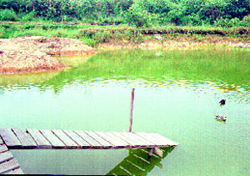 |
|
Lake
|
 |
| |
|
|
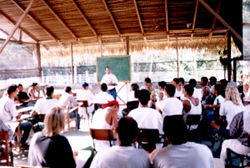 |
|
Permaculture
Classes
|
| |
|
|
|
 |
ZONE
THREE
It is a most distant area. It contains a large food forests,
seven hundred meters of swales and full productive aquaculture
pond. Planted in this zone are perennials that don't need daily
management. At this time, we are working to establish a complete
aquaculture system in this zone. Here, a diverse number of species
will be raised including; fish, turtles, mollusks, aquatic plants
and aquatic birds. Zone three is important for the establishment
of food forests and valuable timber species in order to generate
a rich and diverse production of wild commercial species and other
elements essential to the health of a Permaculture System. A large
scale compost and worm operation in Zone 3 has made possible a
large plantation of fruit and medicinal trees and an extensive
food forest system which now enjoys a closed canopy.

|
Acquaculture
|
| |
|
|
| |
|
|
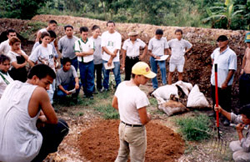 |
|
Practical
Class
|
| |
|
|
Project
Experience
Much of Brazil's rural history is recent and communities have
not had the benefit of shared and useful knowledge that is traditionally
handed down through the generations. Most small farmers lack knowledge
about the available resources in nature, how nature really works
and the practical information on how to utilize them. Change is
difficult in rural areas. Our project staff is based on experienced
professionals, long working with permaculture and leading environmental
projects within the Amazonian region. Several permaculture design
courses have been given since the beginning of the project. More
than 700 local people have been trained. At the same time, the
project is creating two other small demonstrative resource centers,
in two separate communities.
We have completed the first stage of the project by putting this
model on the ground. It is serving as an important educational
tool for students and farmers and more importantly, government
authorities and other NGO's. A local cooperative will be formed
from our extension work with farmers and small business. Part
of our objectives for the second state of the project is to expand
this process and develop a certified organic market for both cultivated
and sustainably derived Amazonian forest products. There is now
a new front of action to begin a major educational program that
will look for and train new local leaders in ground Permaculture
activities. The project will be the site for an advance Permaculture
educational program as part of an agenda that is being design
on a national level.
We know that the problems of rural communities are fundamental:
water, appropriate shelter, energy, food production and earth
care. We also know that an integrated training program can make
a big difference on the community level. The construction of ferrocement
water tanks (for example) can collect free and clean rainwater
from roofs. These water tanks can be built in two days and are
six times cheaper that concrete tanks. The heart of our challenge
lies with education and our ability to present organized information
at the most practical level. We feel that our project is a model
for the region since, ultimately, it is society that determines
the fate of its own environment and permaculture is an ecological
design science whose methodology ensures a productive long term
social interaction with nature.
|
|
| |
|
|
|
|
|
|

